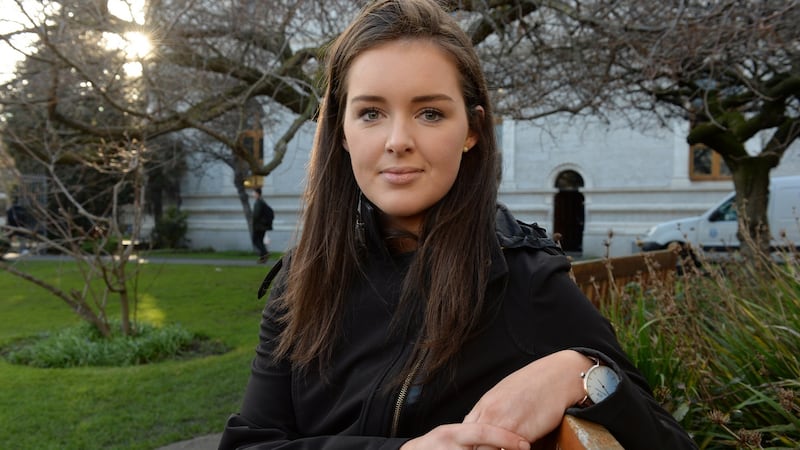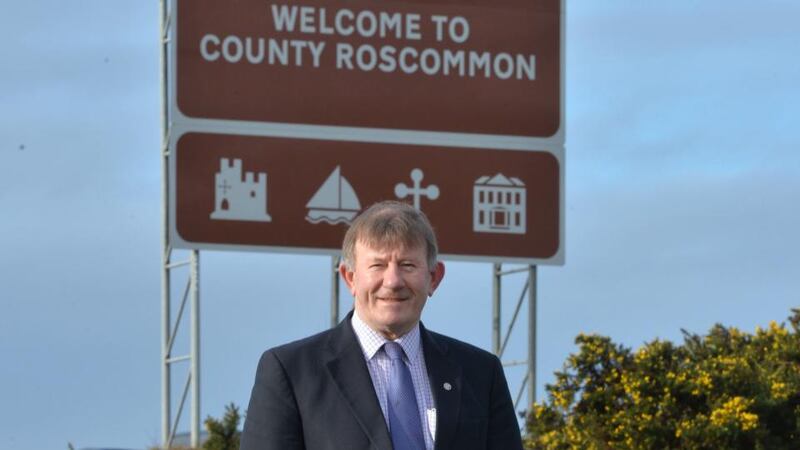In 1899, a small area west of the Shannon, now known as West Athlone, was ceded from Co Roscommon to Co Westmeath. Driving through this area from Athlone today it seems less well maintained than the east side of town. There are 47 closed, boarded-up businesses in the area, which once was a thriving town.
“The whole west side of Athlone has been decimated,” says Tony White, a retiree from south Roscommon.
Over the years, many of the local amenities have moved to the east side of the bridge. The train and bus stations, the department of social welfare, the local library, the council offices, and the local bank branch along with local shops have all moved east of the bridge.


“Nothing came this side,” says James Kilmartin, secretary of the Monksland Community Centre in south Roscommon. His family has lived in Roscommon for five generations.
“If you go back years ago and look, there was a suggestion put in that they knock Athlone Castle and put a car park in instead and it was one vote that stopped it. I always say one thing: if they could move St Peter’s Church and Athlone Castle across to the east, they would.”
In south Roscommon, locals feel the portion of Athlone west of the Shannon has been forgotten under Westmeath County Council.
“The west side has been going into decline since the 1970s. They haven’t really put investment into the area. Athlone town benefited from the boom but even during boom times the western side of Athlone was falling into decline,” says Edwina Reilly, chair of the Monksland Tidy Towns committee.
This concern was heightened more recently when Athlone was one of four areas (including Drogheda, Carlow and Waterford) chosen by Minister for the Environment Alan Kelly last June to undergo a boundary review, with roughly 35 square kilometres of south Roscommon – including the Monksland area, about 4km to the west of Athlone town centre – potentially being annexed to Westmeath.
Athlone is the 17th largest town in Ireland, with a population of 20,153 people. According to the 2011 census, 3,826 of them live in Roscommon.
Outlining the benefits of the boundary reviews, the Minister has said: “Bringing all of a town or metropolitan district within a single local authority area eliminates anomalies and distortions of divided administration, service provision, regulatory/enforcement responsibility and electoral representation.”
Negative effect
While bringing the Monksland area under Co Westmeath’s authority might benefit Athlone, it would have a
negative effect on Roscommon and its people, according to Ger Aherne, Kiltoom resident and spokesperson for the Save Roscommon campaign.
“There is one shining light in the county of Roscommon, economically and industrially, and that’s a place called Monksland. The reality of all this is that if this were to happen, Roscommon as an entity would be financially unviable. Within 10 years there would be no Co Roscommon,” he says.
Monksland is the second biggest town in Roscommon, after Roscommon town. The Save Roscommon group estimates the area affected by the review is home to about 7,000 people, one in nine of Roscommon’s 64,065 population.
The area has become a hub for pharmaceutical industries since the Elan corporation opened its plant there in the 1970s, where Alkermes Pharma Ireland is now located. Roscommon County Council invested heavily in the area, funding roads, sewerage, water and other infrastructure to allow this hub to grow.
Since then, it has become the fastest- growing town in Roscommon, and an industrial heartland, referred to by Roscommon county manager Eugene Cummins as “the ATM of Roscommon” because of the revenue it generates, when many areas in the county have little industry. The council owns more land in the area; it is already zoned industrial, to allow for further growth.
Save Roscommon estimates the area in question generates €2.5 million a year for the county, between commercial rates, local property tax and road tax. If the boundary changes, the law would require a transfer of central exchequer funds to compensate Roscommon County Council in some way, but Aherne says this is not adequate.
“Why would the people of Roscommon go from the certainty of raising its own taxes to the uncertainty of dependence on central funds?”
Athlone Boundary Review Westmeath’s annexing of this area could have an impact on Roscommon as a whole, because of this removal of revenue. It is also an issue of community and identity for many people in the area, however.
A public meeting in the Athlone Springs Hotel last month drew almost 2,000 local people, and at the closing date for submissions to the Athlone Boundary Review committee at the end of January, Save Roscommon says it had delivered more than 26,000 submissions from local people expressing concern.
“Roscommon people are Roscommon people and that won’t change. I won’t be writing Westmeath on my postal address,” says William Gacquin, a local deacon and historian, and a retired secondary school teacher from the Monksland area.
“Generally it’s that feeling that our identity is being interfered with for no particular reason. Nobody has shown any logical reason why this would be of any benefit to the people who live here.”
“There would be a real sense of loss if this went ahead,” says Katie Rock, a 21-year-old engineering student in Trinity College Dublin, who hopes to one day move back and settle in Cornafulla, near Drum, where she grew up.
“I know it won’t be life-changing, everything will still be the same, strictly speaking, but emotionally and culturally it’ll seem like a part of me has been taken away forcibly, something will be missing. It’ll be a personal loss.”
Demographics
Roscommon has the oldest population by county in Ireland, with 14.6 per cent of its population aged over 65. However, Monksland is well below that county average, at 4.9 per cent over 65. Removing the Monksland area from Roscommon would push the age demographic for the county higher, making Roscommon a less desirable and viable option for Rock and her peers to return to.
“I think this has affected a lot of students in the sense that they would like to be able to come back and settle down. Home isn’t just a place where you grow up and then you move away from, it’s a place you have connections and attachments to. We don’t want to come back and find the blue and yellow is now maroon and white,” she says.
Local councillor and chair of Save Roscommon Tony Ward echoes similar concerns for young people and the county’s future as a result.
“What will that do for the county demographics if you move the young people and a vibrant community to Westmeath? As a councillor I worked with the community here, and there was a lot of work and effort put in by the community and a lot of money spent by Roscommon County Council, and rightly so. It’s for the future of Roscommon,” he says.
Edwina Reilly, along with her Tidy Town committee, has put a lot of work into building up a community in Monksland and says it could be a big loss if the same investment was not forthcoming from Westmeath as it has been from Roscommon.
“In Monksland, Roscommon is putting investment into the area and it’s building up the area, whereas if we went into Westmeath, whatever funding they have for the Tidy Towns would have to be diluted a little bit more to facilitate ourselves. We think we would be put down to the bottom of the pile,” she says.
The GAA tradition in Roscommon is strong. Two big clubs, St Brigid’s and Clann na Gael, would be affected by the boundary review, though beyond the practicalities of where those clubs will play in the future – Roscommon or Westmeath – there’s no doubt the GAA feeds into people’s county identity here.
Identity
Shane Curran was the Roscommon county goalkeeper in the 1990s, and captained the St Brigid’s team that won the All- Ireland Club Football Championship in 2013. Roscommon is part of his identity, he says.
“A huge part of my attachment to Roscommon growing up was the GAA. It was my education in many ways because of the people I’ve met. From the cradle to the grave, you need identity. It’s about where you’re from and no confusion should be brought in.
“What we don’t want here is a Gaza Strip-type place where you’ve got people growing up not knowing where they’re from, Westmeath or Roscommon, or even Leinster or Connacht,” he says.
Ward agrees: “When this all started, there were boys and girls all around, wearing their county tops. A father of a 10- year-old boy said to me: ‘How can I tell him next year that he has the wrong jersey on?’ Identity is everything.”
All change? The arguments for and against
FOR
1. A fifth of Athlone's population lives outside the town boundary. Bringing them within the boundary allows for strategic development of Athlone by one administrative body .
2. To get public and private investment, a critical mass of population and economic activity is necessary. This change would allow Athlone meet those requirements for economic growth of the region.
3. Many South Roscommon people avail of amenities in Athlone, such as the library, but all Westmeath County Council services would be available to Monksland , in Athlone, if the boundary changed.
AGAINST
1. Roscommon County Council receives much of its revenue from the Monksland area and moving this money to Westmeath would have knock-on effects for the whole county.
2. Roscommon people who identify strongly with their county don't want their identity or heritage messed with.
3. Monksland has built up a strong community with the support and funding of Roscommon County Council, and this may be weakened if it becomes just an adjunct to Athlone.










